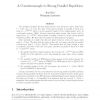Free Online Productivity Tools
i2Speak
i2Symbol
i2OCR
iTex2Img
iWeb2Print
iWeb2Shot
i2Type
iPdf2Split
iPdf2Merge
i2Bopomofo
i2Arabic
i2Style
i2Image
i2PDF
iLatex2Rtf
Sci2ools
FOCS
2008
IEEE
2008
IEEE
A Counterexample to Strong Parallel Repetition
The parallel repetition theorem states that for any two-prover game, with value 1 − (for, say, ≤ 1/2), the value of the game repeated in parallel n times is at most (1 − c)Ω(n/s), where s is the answers’ length (of the original game) and c is a universal constant [R95]. Several researchers asked wether this bound could be improved to (1 − )Ω(n/s); this question is usually referred to as the strong parallel repetition problem. We show that the answer for this question is negative. More precisely, we consider the odd cycle game of size m; a two-prover game with value 1 − 1/2m. We show that the value of the odd cycle game repeated in parallel n times is at least 1 − (1/m) · O( √ n). This implies that for large enough n (say, n ≥ Ω(m2)), the value of the odd cycle game repeated in parallel n times is at least (1 − 1/4m2)O(n). Thus:
FOCS 2008 | Odd Cycle Game | Parallel Repetition | Parallel Repetition Theorem | Theoretical Computer Science |
Related Content
| Added | 29 May 2010 |
| Updated | 29 May 2010 |
| Type | Conference |
| Year | 2008 |
| Where | FOCS |
| Authors | Ran Raz |
Comments (0)

